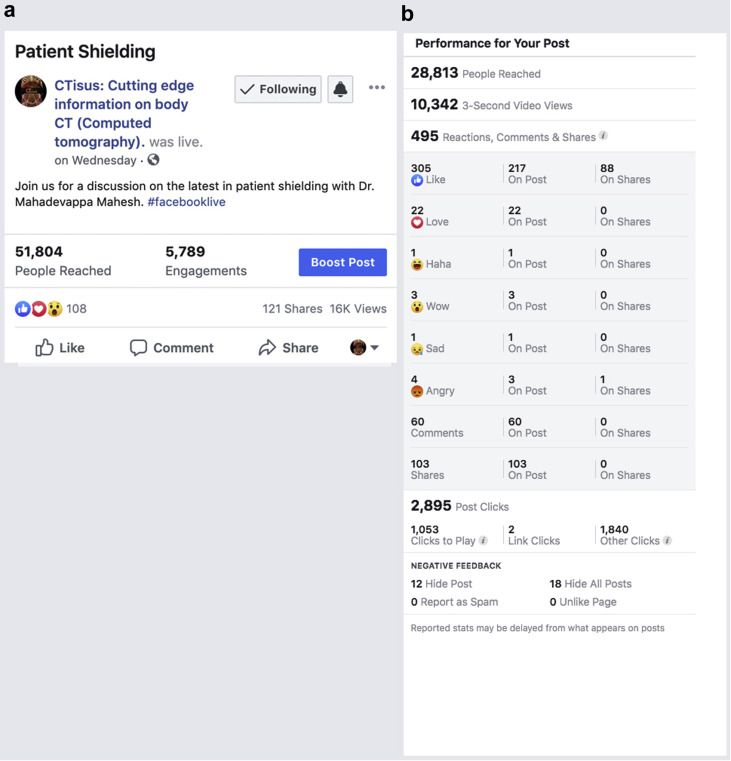Facebook Live Effective Avenue for Sharing Radiology Knowledge
Johns Hopkins shares its experience with hosting live events, garnering international participation.

Fig 1(a) Our Facebook Live statistics overview includes how many people were reached, the number of engagements on the post (clicks, comments, etc), and the reactions, views, comments, and shares associated with the original video. This information is for the Patient Shielding segment after 48 hours. (b) More detailed Facebook Live statistics show how many people were reached, how many views the video drew, and the breakdown of reactions by type, comments, and shares associated with the original video. This information is for the coronavirus disease 2019 segment after 48 hours. Courtesy: JACR

Facebook Live can be an effective tool to easily and quickly introduce thousands of radiologists to new and developing topics in the industry, according to industry leaders.
In recent months, Johns Hopkins Medicine has hosted two Facebook Live sessions – one in January and March, each – that focused on patient shielding and the COVID-19 pandemic. Each time, they included a prominent thought leader who could discuss the topics extensively, as well as answer audience questions.
Researchers shared their experience in a May 29 article in the Journal of the American College of Radiology.
“There is great potential in using Facebook Live for radiology education,” wrote a research team led by Elliot Fishman, M.D., radiology professor and director of diagnostic imaging and body computed tomography at Johns Hopkins. “Because it is free and educators can exert as much or as little effort as they desire, it is a time- and cost-effective way to research thousand of people within hours.”
Johns Hopkins initially launched a Facebook page for its CTisus.com website in 2009, eventually garnering 235,000 followers. With the advent of Facebook Live in 2015, the institution decided to test whether radiology educators could use the platform to reach a wider audience.
Its initial attempt – a session on patient shielding on Jan. 15 – was based on a New York Times article that quoted a Johns Hopkins expert. Mahadevappa Mahesh, M.D., Ph.D., professor of radiology and radiological sciences and chief physicist at The Johns Hopkins Hospital, spoke live during the event. Within 24 hours, 30,000 viewers had watched the 20-minute video around the world, including in Saudi Arabia, Sweden, and England. Ultimately, nearly 52,000 people viewed the event.
In addition to calculating overall viewership, the team noted that 8,300 viewers watched for more than three seconds. They also counted 178 reactions and 61 comments on the day of broadcast.
The team created a second event on March 26, focusing on the COVID-19 pandemic. It included a PowerPoint presentation and a 25-minute discussion with Fishman about the radiological findings of the virus and Hopkins’ new reporting template. Within the first day, approximately 26,000 people watched the video with more than 8,700 lingering for more than three seconds. Overall, this event gleaned 296 reactions, 58 comments, and 87 shares.
Ultimately, the team reported, their experience with Facebook Live was positive, and they recommended other institutions investigate how to best use this platform or others for widespread education and conversation.
“The field of radiology education might benefit itself and its users by meeting people where they are,” they wrote. “Increasingly, that is in the digital world.”
The Reading Room Podcast: Emerging Trends in the Radiology Workforce
February 11th 2022Richard Duszak, MD, and Mina Makary, MD, discuss a number of issues, ranging from demographic trends and NPRPs to physician burnout and medical student recruitment, that figure to impact the radiology workforce now and in the near future.
New Collaboration Offers Promise of Automating Prior Authorizations in Radiology with AI
March 26th 2025In addition to a variety of tools to promote radiology workflow efficiencies, the integration of the Gravity AI tools into the PowerServer RIS platform may reduce time-consuming prior authorizations to minutes for completion.